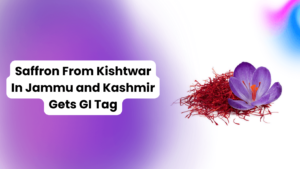Introduction:
Kishtwar saffron, a highly coveted spice that is grown and harvested in the Kishtwar Region of Jammu and Kashmir, was recently awarded the famous Geographical Indication (GI) label by the Geographical Indications Registry—a designation that is considered to be among the most prestigious in the world.
The saffron that is grown in the Kishtwar district of Jammu is already renowned for its exceptional quality and distinctive individuality, but this recognition strengthens and strengthens its reputation even further.
Kishtwar Region’s Agricultural Productivity
- It is in the magnificent Kishtwar region, which is located in the rugged terrains of Jammu, that the Kishtwar saffron is said to have originated.
- This spice, which is referred to as “KUNG” in the local community and “KESAR” in the national community, is an essential cash crop in this remote location.
- Because the saffron production area, which is appropriately called Mandal, encompasses approximately 120 hectares of cultivable land, Kishtwar has become an important hub for the cultivation of saffron products.
Kumkum, the Most Fruitful Harvest of All
- Kishtwar is well-known for being the location that produces the most expensive crop of saffron, which is more commonly referred to as Kumkum.
- In addition to being a symbol of the economic significance of saffron cultivation, this famous variety also carries cultural significance because it is a depiction of the characteristics of freshness and purity.
- In the region, saffron, which is known by the Sanskrit name “Kum-Kum” or “Lohit,” is considered to be a cultural heritage substance.
In terms of quality, Kishtwar and Pampore are compared.
Even when compared to the well-known Pampore saffron that comes from Kashmir, the quality of the saffron that comes from Kishtwar clearly stands out.
This superiority can be linked to a number of different variables, including the quality of the land, the environment, and the precise skill of picking flowers and separating the petals from the red and yellow carpels.
Practices in Agriculture and Obstacles to Overcome
The growing of saffron in Kishtwar is a labor-intensive procedure that requires meticulous attention and attention all the time. For a satisfactory harvest, it is essential to have a moderate amount of rainfall during the planting of bulbs and blossoming, respectively.
The annual harvest of around five quintals exemplifies both the commitment of the local farmers and the difficulties they encounter in the process of preserving their saffron fields during the growing season.
Understanding the Cultural and Medicinal Importance of Saffron
- In addition to its significance in the economy, saffron is also of cultural and therapeutic significance in the region.
- Although it is referred to as “Zafron” in Persian, it is not just a condiment that is utilized in the culinary arts but also has a place in the traditions of Hinduism.
- A mark known as a tilak is applied to the forehead by Hindus in India. They believe that the aroma and color of saffron are meant to bring good fortune.
- The spice is also used in the production of pharmaceuticals, and it is used in cooking to impart a flavor that is mild, digestive, sedative, and exhilarating.
Impact on the Economy and Potential Medical Benefits
Growers in Kishtwar have seen considerable improvements in their economic circumstances as a result of their involvement in the growing of saffron.
The strong therapeutic value of saffron has resulted in it becoming a commodity that is in high demand.
Saffron carpels that have been crushed and combined with milk produce a nutritious tonic that exemplifies the numerous applications and advantages of this precious spice.











